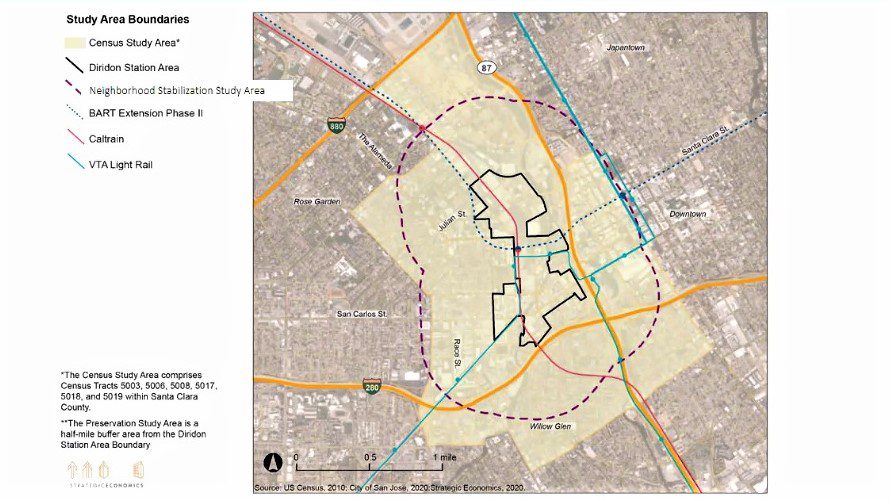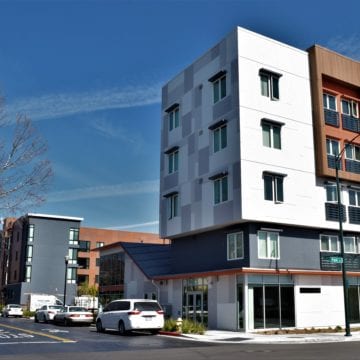San Jose wants 25% of homes in the Diridon Station Area — where Google aims to build an 80-acre campus for roughly 20,000 workers — to be designated as affordable. But how will it reach that goal?
Housing policy thinktank Silicon Valley at Home and the San Jose Housing Department led a meeting this month to detail the goals for affordable housing in the area, including a plan to prevent displacement of people living nearby.
The solution, they said, is to unleash a range of anti-displacement and preservation strategies — including adding 11,000 duplexes to the city’s rent control program.
“We need to be accountable for the housing impact of all of these new jobs,” said Mathew Reed, policy manager at SV@Home.

The city aims to maintain the number of low-income renter households in neighborhoods closest to Diridon Station, as well as the number of deed-restricted affordable housing units — homes reserved for low- to moderate-income owners — through 2040.
To reach that goal, the Housing Department hopes to acquire and rehabilitate older apartments and convert “naturally affordable” apartments — those already priced affordably based on market conditions — into deed-restricted affordable housing. Officials are also looking to expand the city’s tenant protections, including a rule that requires landlords to have reasonable grounds for eviction, to all units.
City officials also want to extend the city’s rent control law to include duplexes.
In 2017, then-Councilmember Don Rocha asked city officials to study the inclusion of duplexes in the rent control program. But Housing Director Jacky Morales-Ferrand argued against including duplexes at the time, given that most duplex landlords don’t how to operate under rent control. She also said adding duplexes to the city’s rent control program would dramatically increase the Housing Department’s workload — roughly 11,000 units would have been added to the program, an increase of 25%.
Kristen Clements, division manager for the Housing Department’s policy group, said drafting an affordable housing plan in an area facing so many new developments — including the eventual arrival of high-speed rail and BART — presents unique challenges and opportunities.
“There aren’t that many large station developments in the country,” Clements said. “We can be in on the ground floor and help design and give input as to what is going to go forward there and who gets to live in the station area.”
The elephant in the room was Google’s proposed megacampus, which will consume about a third of the land in the area and could drive up rents across the city.
Economists have estimated that each new employee working at the Google campus will increase the cost of rent for existing tenants by $735 per month by 2030.
It is unclear exactly how Google would aid the city’s affordable housing goals. The company plans to build between 4,000 and 5,900 housing units near its proposed campus, but the city has not yet wrested a specific housing commitment from the tech giant.
Google and the city had planned to release a development agreement — including a community benefits plan — for the project on March 8, but the release date has been postponed indefinitely. The city is still crafting the legal language around the agreement, according to the DiridonSJ.org website.
In the meantime, city officials hope to enact strategies to fight displacement, including updating building codes to allow for lower-cost construction technology and materials. The city is also studying whether to prioritize the use of commercial linkage fee revenues — fees charged per square foot to fund affordable housing — for projects within the Diridon Station Area, as well as reducing or eliminating fees that would fund the city’s parks.
Morales-Ferrand said the biggest obstacle to building affordable housing is the high cost of land. Available lots in the nearby 95126 and 95112 ZIP codes, for example, are being offered at roughly $10 million per acre.
“The biggest challenge we fear is that we’re not going to have the opportunity to develop (housing),” Morales-Ferrand said. “You could have all the money in the world, but if you don’t have land, it makes it impossible to move forward.”
Morales-Ferrand said she hopes Google and other property owners will donate some land near Diridon Station to build affordable housing.
Clements said the San Jose Planning Commission will review the city’s proposed Diridon Station Area Plan next month, though no April meetings have been posted yet on the city’s meetings portal. The City Council is expected to vote on the plan, as well as the city’s affordable housing plan for the area, in May.
Readers can review a draft of the affordable housing plan here.





